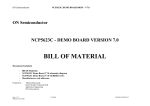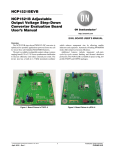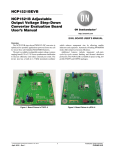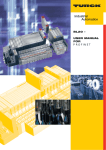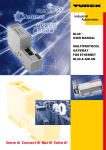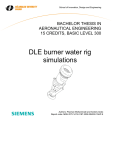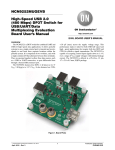Download NCP5612GEVB Evaluation Board User`s Manual
Transcript
NCP5612GEVB NCP5612GEVB Evaluation Board User's Manual http://onsemi.com EVAL BOARD USER’S MANUAL Description This evaluation board manual contains: The NCP5612 product is a dual output LED driver dedicated to the LCD display backlighting. The built-in DC-DC converter is based on a high efficient charge pump structure with operating mode 1x and 1.5x.It provides a peak 87% efficiency together with a 0.2% LED to LED matching. • • • • Bill of Materials NCP5612 Demo Board V1.0 schematic diagram NCP5612 Demo Board V1.0 GERBER views Manufacturers’ web addresses Figure 1. NCP5612GEVB Evaluation Board − Details of the Input Power Supply Pins & Digital Control Socket © Semiconductor Components Industries, LLC, 2012 February, 2012 − Rev. 1 1 Publication Order Number: EVBUM2016/D NCP5612GEVB C1 GND 4.7uF/10V VBAT J1 220nF/6.3V 220nF/6.3V 2 1 C2 POWER TP2 VOUT C3 S−WIRE PORT 6 CNTL 2 SP1 8 C2 P 9 C2N 10 Vout Vbat GND 7 VOUT 2 LED1 D1 3 LED2 C4 1uF/10V NC U1 NCP5612 1 TP1 CNTL 5 CNTL 4 3 1 3 5 7 9 C1P 11 J2 2 4 6 8 10 C1 N 12 GND IREF LED1 LWY87S GND 1 LED/ICON 10 k R1 IREFBK GND Z1 GND GND Figure 2. NCP5612GEVB Evaluation Board Schematic http://onsemi.com 2 D2 LWY87S NCP5612GEVB Table 1. Bill of Materials QTY Designator 1 R1 Footprint Manufacturer 10 kW 2 Description 0603 Vishay Draloric C2, C3 220 nF / 10 V 0603 TDK C1005X5R1C224MT Reference design 1 C1 4.7 mF / 10 V 0805 TDK C2012X5R1C475MT Reference design 1 C4 1 mF / 10 V 0805 TDK C2012X5R1C105MT Reference design 1 U1 NCP5612 LLGA12 ON Semiconductor NCP5612 Reference design 2 D1, D2 LWY87S OSRAM_LED OSRAM LWY87S Reference design 2 TP1, TP2 Test Point TEST_POINT KEYSTONE 5005 ( THM ) RS = 203−4910 Do not assemble 1 J2 IDC10 3M Electronique 2510−6002 UG RS = 120−7230 ANSLEY 4−1437044−3 RS = 461−742 Control Port Part Number Comments Any other suppliers possible 1 J1 Connector RAD0.4 KONTEK COMATEL 3110014000500 RS = 305−0907 (J2 is built with two pins as depicted in the photo) 1 Z1 GROUND GND_TEST HARWIN D3082−01 (tin) D3082−05 (gold) RS = 160−3745 (tin) 1. RS = Radio Spares 2. any resistors with same footprint, tolerance up to ±5% together with TC < 500 ppm and +1055°C operating temperature range can fit the application. 3. using X5R type ceramic capacitor is preferred. Using X7R brings extended operating temperature range. Using Y5R material shall be avoided due to the wide tolerance spread over the temperature range. Using smaller foot print capacitor is discouraged to avoid audible noise issue with the ceramic. ASSEMBLY Note: the here attached photos are used as a visual reference: 1. Assemble the NCP5612 ( LLGA12 package) , Hot Air Flow Process mandatory 2. Assemble all the passive parts 3. Assemble all the White LED 4. Assemble the GROUND reference point 5. Assemble the control port IDC10 connector, make sure the connector is properly oriented: the white triangle, on the PCB, is the pin 1 reference 6. Assemble the power supply pins. At this point, the system is ready to operate. http://onsemi.com 3 NCP5612GEVB TEST CONDITIONS Power Supply: Connect a DC power supp ly , with 500 mA output current capability, across the two pins built with connector J2. Make sure the polarity is properly respected: reverse polarity will destroy the NCP5612. Set up the power polarity to 3.6 V. Although the supply voltage can be adjusted between 2.85 V − 5.5 V for engineering purpose, the associated MCU test board is limited to 3.6 V: double check the power supply before to turn ON the supply. Manufacturing Final Test: 1. Connect the IDC10/J1 connector to the external MCU board with the ribbon cable. Double check the power supply is set up at 3.6 V, maximum rating is 3.8 V. 2. The MCU board is powered by the same external DC supply once the ribbon cable ia attached on both boards. 3. Turn ON the power supply: LED D1 on the MCU board shall turn ON. Reset the MCU if necessary by pushing the RESET button S7 4. Push control button F3: the ICON mode shall be activated, LED 2 being ON with a low current. At this point, the current absorbed by the system shall be in the 4 mA range. 5. Push control button F1: the two LED shall be activated and the brightness can be increased by pushing the F1 control. 6. Push control button F2: the two LED shall be dimmed toward zero with consecutive pushes on the F2 command. 7. Push command F3: the ICON mode shall be activated, same as #4 Since bounces are generated by the manual push buttons, non linear operation can happen during the test. This is normal and the part shall NOT be rejected for such a reason. The final test is complete when all the steps #4 to #7 are proven OK. It is not necessary to cover all the sixteen steps to ramp up/ down the brightness: the system is fully debugged if the four tests mentioned above are successful. Digital Control: it is possible to drive the NCP5612 by means of an external controller, leaving aside the MCU test package. In this case, one shall connect an external pulse generator to connect J1 /IDC10. The external controller shall send the data according to the SWIRE protocol depicted into the NCP5612 data sheet. The chip is capable to support a 100 kHz transfer rate. System Operation: 1. Double check the power supply is set up between 3.0 V to 5.5 V, make sure the external MCU can support the same power supply range. 2. Turn ON the power supply 3. Send the appropriate data frame to control the two LED Note: the MCU board is reserved for manufacturing only and is NOT provided with the NCP5612 evaluation board http://onsemi.com 4 NCP5612GEVB Figure 3. NCP5612GEVB Evaluation Board & MCU Controller Silk Views Figure 4. NCP5612GEVB Evaluation Board: TOP & BOTTOM Views http://onsemi.com 5 NCP5612GEVB COMPONENT MANUFACTURERS Vishay − Draloric TDK BC Components http://www.vishay.com/resistors−discrete/ http://www.component.tdk.com/ http://bccomponents.com/ Radio Spares: in the USA, see ALLIED ELECTRONICS Inc. 7410, Pebble Drive Forth Worth / Texas / 76118−6997 Phone: 817−595−3500 ON Semiconductor and are registered trademarks of Semiconductor Components Industries, LLC (SCILLC). SCILLC reserves the right to make changes without further notice to any products herein. SCILLC makes no warranty, representation or guarantee regarding the suitability of its products for any particular purpose, nor does SCILLC assume any liability arising out of the application or use of any product or circuit, and specifically disclaims any and all liability, including without limitation special, consequential or incidental damages. “Typical” parameters which may be provided in SCILLC data sheets and/or specifications can and do vary in different applications and actual performance may vary over time. All operating parameters, including “Typicals” must be validated for each customer application by customer’s technical experts. SCILLC does not convey any license under its patent rights nor the rights of others. SCILLC products are not designed, intended, or authorized for use as components in systems intended for surgical implant into the body, or other applications intended to support or sustain life, or for any other application in which the failure of the SCILLC product could create a situation where personal injury or death may occur. Should Buyer purchase or use SCILLC products for any such unintended or unauthorized application, Buyer shall indemnify and hold SCILLC and its officers, employees, subsidiaries, affiliates, and distributors harmless against all claims, costs, damages, and expenses, and reasonable attorney fees arising out of, directly or indirectly, any claim of personal injury or death associated with such unintended or unauthorized use, even if such claim alleges that SCILLC was negligent regarding the design or manufacture of the part. SCILLC is an Equal Opportunity/Affirmative Action Employer. This literature is subject to all applicable copyright laws and is not for resale in any manner. PUBLICATION ORDERING INFORMATION LITERATURE FULFILLMENT: Literature Distribution Center for ON Semiconductor P.O. Box 5163, Denver, Colorado 80217 USA Phone: 303−675−2175 or 800−344−3860 Toll Free USA/Canada Fax: 303−675−2176 or 800−344−3867 Toll Free USA/Canada Email: [email protected] N. American Technical Support: 800−282−9855 Toll Free USA/Canada Europe, Middle East and Africa Technical Support: Phone: 421 33 790 2910 Japan Customer Focus Center Phone: 81−3−5817−1050 http://onsemi.com 6 ON Semiconductor Website: www.onsemi.com Order Literature: http://www.onsemi.com/orderlit For additional information, please contact your local Sales Representative EVBUM2016/D






